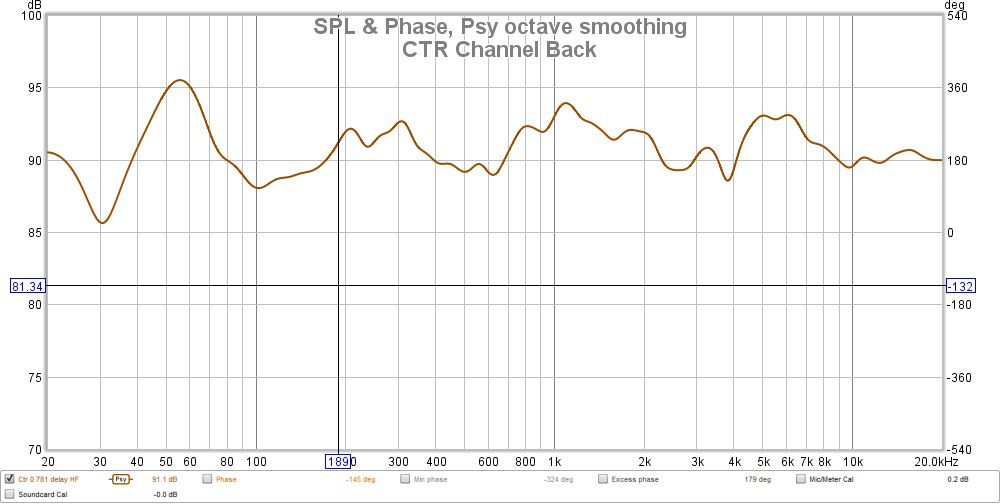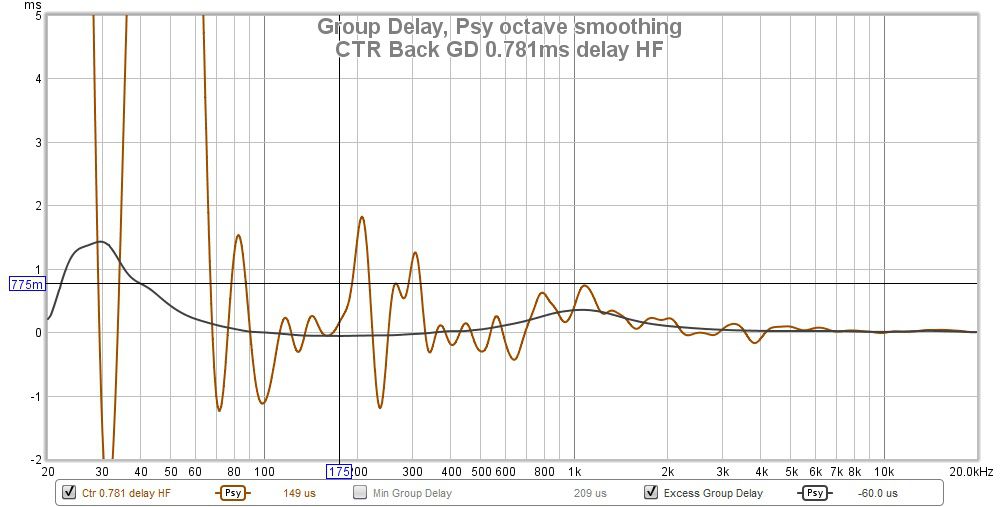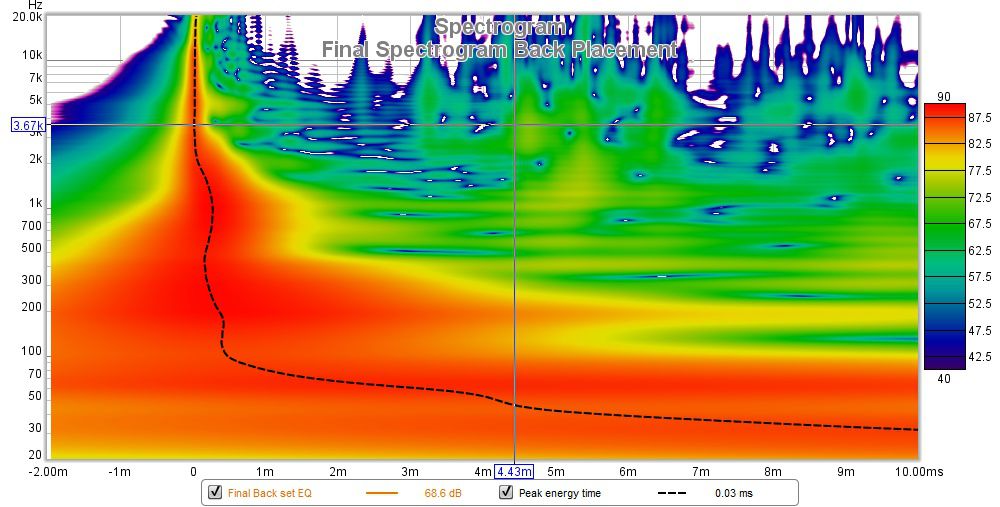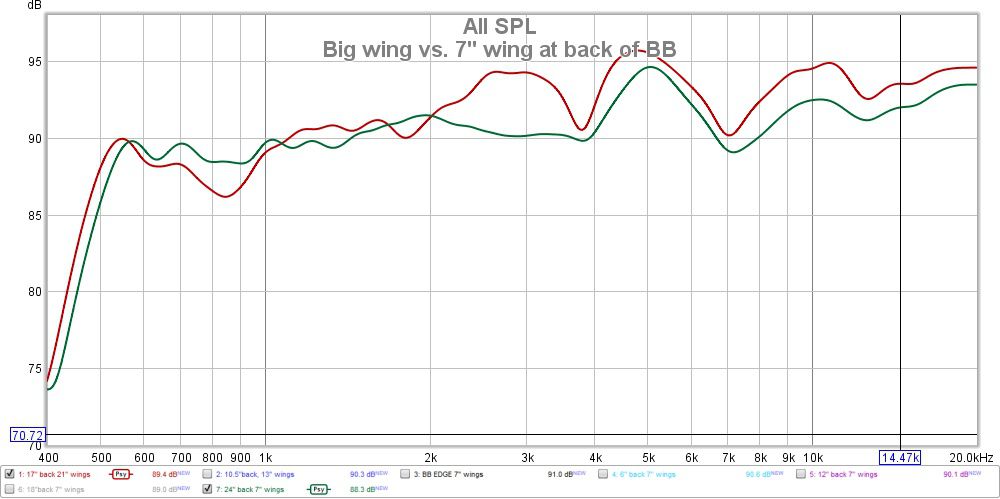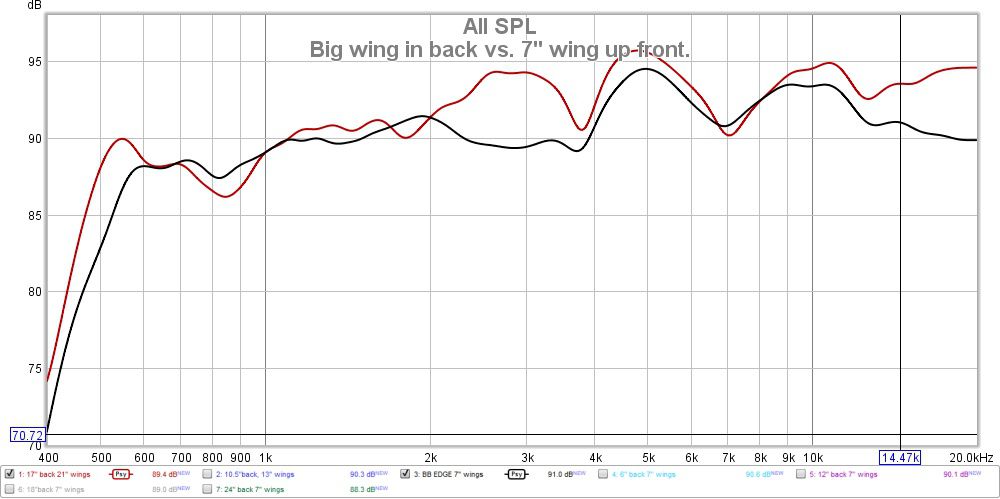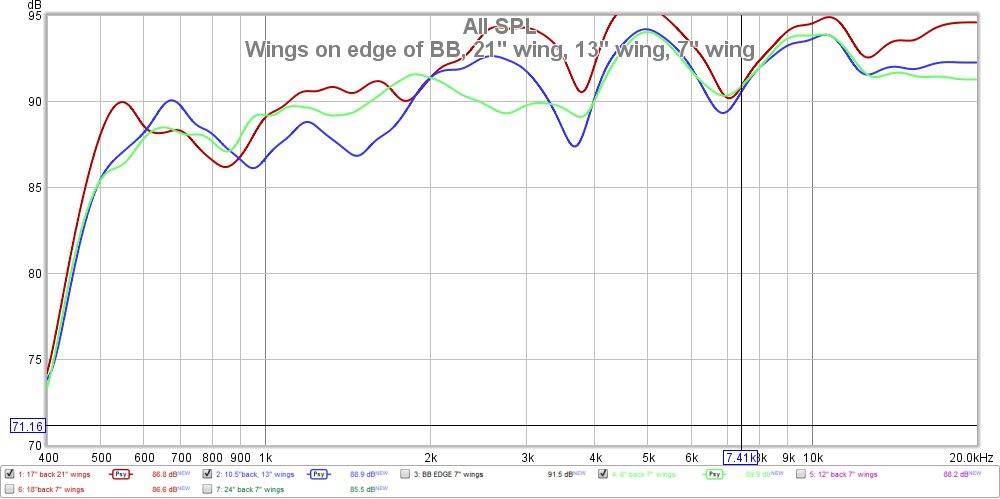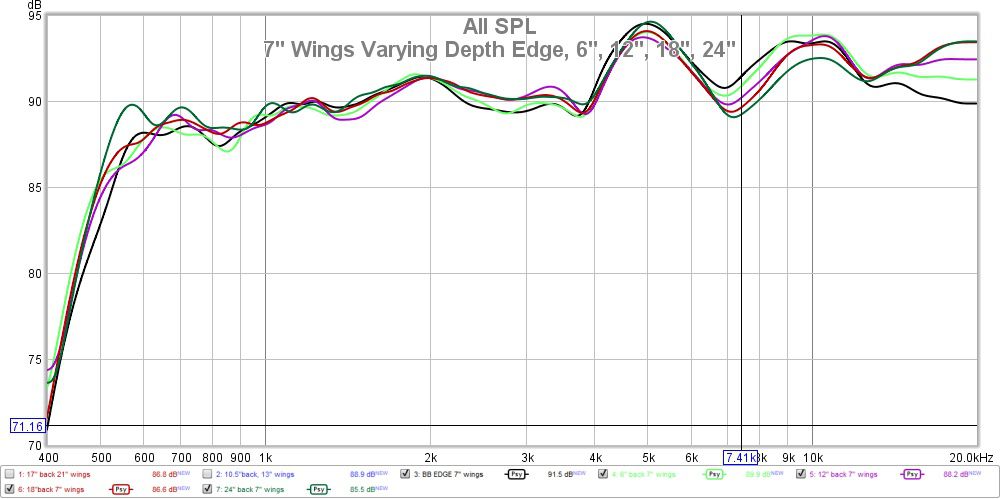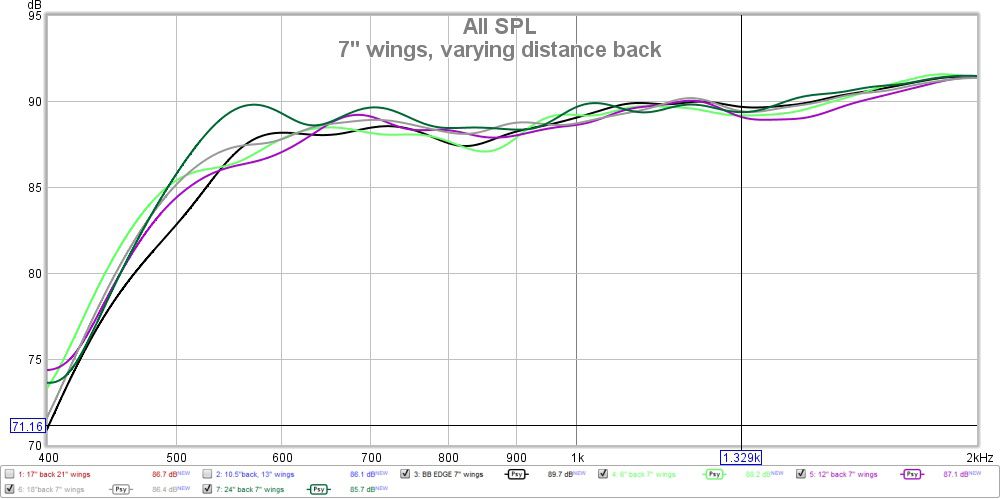-
Posts
3556 -
Joined
-
Last visited
-
Days Won
2
Content Type
Forums
Events
Gallery
Everything posted by Rudy81
-

Double Stack ESS AMT-1 with Wings--Possible Kit for Heritage
Rudy81 replied to Chris A's topic in Technical/Restorations
@Delicious2, my condolences during this difficult time. Take care of your family. We'll still be here when you have time to devote to this. -

New Project: Chop top LS with Double Stack ESS AMT-1
Rudy81 replied to Thaddeus Smith's topic in Technical/Restorations
I suspect DSP won't solve the problem. If it is a resonance issue, you will simply have to work on bracing as best you can. Baltic Birch around here runs between $75 and $125 a sheet depending on source and size spec. -

New Project: Chop top LS with Double Stack ESS AMT-1
Rudy81 replied to Thaddeus Smith's topic in Technical/Restorations
I seem to remember some folks have placed horizontal bracing on the LaS bass bin to shore up that problem. Have you tried that? -

Double Stack ESS AMT-1 with Wings--Possible Kit for Heritage
Rudy81 replied to Chris A's topic in Technical/Restorations
The brains behind all this is @Chris A. It was our discussion on group delay using REW that led me to discover the Heil. I had never even heard of it. I was floored when Chris told me it was technology that has been around since the 1970's. I continue to really enjoy my listening sessions. I'm still floored by the sound and ambience it creates. I'm sure some will eventually disagree, but for me, these are still great drivers. Now that we have looked at wing length and stack positioning, my next project is to build an X shaped set of waveguides. That is, identical wings both front and back. Chris indicated that the back wave would benefit from a more symmetrical design for the dipole driver. Hopefully others will come up with even better ideas. Again, as Chris mentioned, please give the drivers a little break in time before jumping into high SPL tests. I do know the drivers 'change' after break in, and don't know if they could be damaged by high SPL when new....but better safe than sorry. Those diaphragms, although easy to change, are expensive. -

Double Stack ESS AMT-1 with Wings--Possible Kit for Heritage
Rudy81 replied to Chris A's topic in Technical/Restorations
@dkalsi, don't freak out yet! @Chris A is correct about breaking in the drivers. I noted anomalies also when the drivers were new. What I have done is to hook up the drivers and let them play music for a day or so. Last time I did that I looked at the anomalies before and after. There is something to this 'break in' period for these drivers. I have been gentle with them until I feel they have broken in. The questions is, what are your first impressions of the overall sound? -

Double Stack ESS AMT-1 with Wings--Possible Kit for Heritage
Rudy81 replied to Chris A's topic in Technical/Restorations
Me too! Although my third order took longer than the first two and I never got shipping confirmation. Not a big deal as long as I got it. -

New Project: Chop top LS with Double Stack ESS AMT-1
Rudy81 replied to Thaddeus Smith's topic in Technical/Restorations
Dang dude! I missed this thread. You are making serious sawdust. -
I've had several irons in the audio fire and this topic was one of them. Seems I finally hit on a combination that will work for me. I looked at Rpi, but decided to keep looking for a suitable pc based solution. I purchased a used Intel NUC with 8Gig memory and an SSD. I installed SnakeOil OS as that has been my preferred option due to it being open source AND it has many players you can try. It is designed and operates as a headless OS for your music. I had some issues originally with my current HTPC. I am sick and tired of Windows 10 running updates and having high overhead. This little Intel Nuc turned out to be perfect with the SnakeOil OS. Install went well and I have everything running except for the HDMI connection. Not a huge deal and am using optical SPDIF. All my .flac music is on a single drive with the OS. I have always preferred JRiver for my music and was able to install the Linux Jriver in SnakeOil. So far, it has worked perfectly and so I purchased an upgrade JRiver Master license for version 26 so I can update all my machines. So far.....a dedicated audio OS like SnakeOil is working great. I still have a lot to learn with this OS, but I got it up and running.
-

Double Stack ESS AMT-1 with Wings--Possible Kit for Heritage
Rudy81 replied to Chris A's topic in Technical/Restorations
You can start here, but Chris discusses it in several posts. -

Double Stack ESS AMT-1 with Wings--Possible Kit for Heritage
Rudy81 replied to Chris A's topic in Technical/Restorations
Well, this didn't take long at all. Please remember this is my purely subjective impression and you will have to play around with your system to find what you like. The following differences are super obvious and it took just a couple of minutes of music to notice. First, my bass bins are 30" off the floor. This may become important if you are using a Khorn, or other tall bass bin. I noted two major audible differences immediately, and eventually moved the stack forward again to see if I was imagining the difference. Moving the stack back caused the following: - Image was very similar to the same. - Soundstage was a little less engaging, but not a deal breaker. What is a deal breaker is that the entire sound stage moved UP, as though it was now above my head. It is very obvious that the sound was now above me, not directly in front of me. When I moved the stack back up front, the sound stage moved down to where it normally has been, in front of my listening position. This is less than desirable for my sitting LP. However, this could be a big plus if you are using this setup in a shop or garage where you are normally standing when listening. This little test seems to confirm that for me, I prefer the stack closer to the edge of the bass bin. I find the soundstage just a little more expansive and 3 dimensional. The big and obvious difference is the perceived 'height' of the soundstage. What might be really cool is to have the stack back for movies, so the sound is at the height of my video screen. But, for music I prefer the forward position thus far. Back for more listening..... Edit: After more listening, the above is confirmed. Overall, in my room, the more you move the stack toward the back of the bass bin, the more the soundstange moves up. Also, you start to lose some of the 'magic' these drivers produce. YMMV, this is just my impressions and I would like to hear what you guys find as time goes on. The closer to the edge, the more the high's sparkle and the more airy and open the soundstage becomes. Honestly, I hate using all these 'audiophile' terms, but it is the only way I can telegraph what I am hearing. I am now going to re-time the stack in the current position, wings flush with the front end of the bass bin. I will keep the crossover as low as possible and go on to enjoying the setup until you guys have a chance to get your drivers and do some experimenting. -

Double Stack ESS AMT-1 with Wings--Possible Kit for Heritage
Rudy81 replied to Chris A's topic in Technical/Restorations
Just finished the new timing and EQ setup with the Stacks at the back of my bass bins. Distance of drivers from BB front is 23.5". After spending some time looking at the various distance plots I took yesterday for my 7" wings, I felt the rear most position offered the lowest cross-able frequency. I estimate the crossover point now to be 600hz. The reason I can't give an exact number is that I am using the Danley style no-name crossover. That is, no crossover at all and just Attenuation at the cross frequency. The AMT drops off pretty dramatically below 400 Hz, so I played around with the settings until I got something that at least 'looks' good on the graphs. The Main SPL measurement shows a dropoff of the very high frequency range that is due to mic placement. Once of the issues with taking these measurements is that HF response is very sensitive to mic placement. Since I was mostly interested in the crossover region, I tended to place the mic closer to the center of the AMT and BB vs. getting the optimum AMT response. As it turned out, I needed NO delay for my L/R mains. The center channel needed less than 1ms delay since I cannot move that driver as far back as the others due to the front wall dipole issue and the fact that my movie screen sits right behind the ctr speaker. Here are the graphic results. Now, on to an afternoon of critical listening. -

Double Stack ESS AMT-1 with Wings--Possible Kit for Heritage
Rudy81 replied to Chris A's topic in Technical/Restorations
Great! Thank you sir. That will also make it easier to make exact positioning measurements between speakers. I have the bass bins exactly placed with spikes, and at 150 pounds or so, they don't move on the floor. -

Double Stack ESS AMT-1 with Wings--Possible Kit for Heritage
Rudy81 replied to Chris A's topic in Technical/Restorations
I promise it will be worth the wait! If you decide its not for you, let me know. I may buy your set as a backup. -

Double Stack ESS AMT-1 with Wings--Possible Kit for Heritage
Rudy81 replied to Chris A's topic in Technical/Restorations
Chris, you are likely correct about the AMT and Mr. Smiley, I may have mis-spoken about the manufacturer of the AMT in the Rainier. I've tried to do so much research on the topic I am likely confusing topics. If I get a chance to speak with Ricky at ESS I'll try to get more information. In the mean time, I plan on selecting the best setback location and then just using my ears to select what works best in my room. I suspect that room acoustics will have a greater impact on sound with these drivers than usual due to the dipole effects. Of course, one thing to keep in mind is that my measurements were taken in my room and incorporate some room boundary effects etc. Unfortunately, each user will likely benefit from doing their own testing in their listening environment. My goal right now is to not only improve my experience, but also help provide some idea of what guys can do with a Khorn, LaS, or Cornwall bass bin in terms of crossover frequency. I plan on lowering my crossover frequency to near 500Hz based on the plots from yesterday. The nice thing about your recommendation of a 12" setback is that it should minimize any timing delta. Question Chris....I currently have my structure set on top of 3/4" isolation pucks in hopes of minimizing any bass bin vibration interaction with the AMT. Frankly, not the best 'looking' setup. So, I'm wondering if there is anything worthwhile to be gained by setting the structure on isolation pucks? -

Double Stack ESS AMT-1 with Wings--Possible Kit for Heritage
Rudy81 replied to Chris A's topic in Technical/Restorations
Chris and I looked at the distortion at 100-105dB near 500hz. It was extremely low! These drivers and their technology are a real gem IMHO. When Hawthorne Audio was in business, they crossed the AMT (encased in a horn) at 300Hz!!!! ESS made the AMT but I have not been able to locate the horn manufacturer. If we could find that horn, or build one......well! This was the Hawthorne Rainier OB speaker. -

Double Stack ESS AMT-1 with Wings--Possible Kit for Heritage
Rudy81 replied to Chris A's topic in Technical/Restorations
Most interestingly, when comparing my current 7" wings IF placed at the back of the bass bin to the 21" wings, the response is darn close.....hmmm. The 7" wings seem to have a flatter overall response and identical performance at 566Hz. The difference below that point is about 3dB in favor of the big wings. All this to say: Chris was correct...again! Based on this comparison, I am leaning toward keeping my 7" wings and moving them way back on the bass bin. The down side to moving them back is that the AMT stack will now be closer to the front wall. I will still have a little over 3 feet to the wall, so should be ok concerning the dipole. I really like the flat response of the green line in the 600hz-2khz region. That is nice! Of course, the big test will be the 'sound'. What I have found to be the best part of these drivers is the open, airy feeling with a gigantic, yet accurate, soundstage. I won't do anything to lose that. I will report my findings tomorrow...hopefully. -

Double Stack ESS AMT-1 with Wings--Possible Kit for Heritage
Rudy81 replied to Chris A's topic in Technical/Restorations
In looking at just my current 7" setup with the edge of the driver at the edge of the BB, vs. the big 21" wings near the back of the BB this is the plot. Seems like a worthwhile difference to me. I will have to start doing listening tests like that and fashion some wing extensions. -

Double Stack ESS AMT-1 with Wings--Possible Kit for Heritage
Rudy81 replied to Chris A's topic in Technical/Restorations
Yes, that was my initial impression, but I plan on revisiting that listening session tomorrow. -

Double Stack ESS AMT-1 with Wings--Possible Kit for Heritage
Rudy81 replied to Chris A's topic in Technical/Restorations
Adding an extreme closeup of the more importance differences. Red line here is the 21" wings with the structure 17" back. The deep blue line is the 13" wing structure at 10.5" back from the BB edge. The light blue line is the set of 7" wings, 6" back from the BB edge. Finally, the black line is the structure at the edge of the BB. You can clearly see performance at the low end improves with longer wings and further back along the top of the bass bin. The question of course will be, what are the 'sound' differences in terms of soundstage and 'air' from the stack. More testing to follow for sure. -

Double Stack ESS AMT-1 with Wings--Possible Kit for Heritage
Rudy81 replied to Chris A's topic in Technical/Restorations
Again my apologies gents. I made an error during my last set of sweeps when I de-selected the EQ and bass bin effect from the response. Turns out I was working with the speaker I wasn't measuring. The 'real' results make more sense in my mind. In the nut shell, all the distance and wing changes make small changes in response overall. Nothing stands out, IMHO, as a must have, BUT, there is something to be gained by either enlarging the wings or moving the structure back. The difference are not huge, but they may just get you to the crossover point you want. I made a quick addition to my 7" wings to make one set at 13" and one large set at 21". I had to redo the distance sweeps now that I corrected my error. Overall, starts to really drop off below 500hz. Which, makes me think we can feasibly xover at 500hz with no problem. The best response below 500Hz was provided by the longer 21" wings, but they showed a lesser performance in the 700hz-1khz region.....so, a trade off, but it can be easily eq'd. Of just the 7" wing tests, the further back you move the structure, the better the response. The wings at the back of my bass bin provided excellent, almost flat response with better low end performance relative to having the wings up front. The plots are now what one would expect. Longer wings, better response. As Chris pointed out, the further back you move the structure, the better the low end. -

Double Stack ESS AMT-1 with Wings--Possible Kit for Heritage
Rudy81 replied to Chris A's topic in Technical/Restorations
I did pure listening tests, of course very subjective, and the stack flush with the edge (Red line) sounded the best. This was last week sometime and have been listening that way since. The other position I listened to, was the 6" back with the wings flush with the BB front. I think what is needed now is a test with wings extended to say 12" and then 18". That may really make a difference. I'll see what I can drum up in the next few days. -

Double Stack ESS AMT-1 with Wings--Possible Kit for Heritage
Rudy81 replied to Chris A's topic in Technical/Restorations
32" deep. -

Double Stack ESS AMT-1 with Wings--Possible Kit for Heritage
Rudy81 replied to Chris A's topic in Technical/Restorations
Posted SPL graphs....deleted due to measurement error on my part....My apologies everyone. I came back to run sweeps with wider wings and realized I likely did NOT take the measurements properly. I will post the 'real' results in a bit a few posts down.....sorry guys. -

Double Stack ESS AMT-1 with Wings--Possible Kit for Heritage
Rudy81 replied to Chris A's topic in Technical/Restorations
As soon as I have some time I will run a series of sweeps at varying distances from the front edge. I want to run just the AMTs so I don't have to set the timing every time I move them. I will provide some pictures and precise distances for each plot. Unless you guys think I should do it differently, I will keep the mic in one position instead of following the AMT stack back. Does that seem like the proper way to do it? -

Double Stack ESS AMT-1 with Wings--Possible Kit for Heritage
Rudy81 replied to Chris A's topic in Technical/Restorations
I suspect ESS is not a huge company and they likely operate on a small scale. Frankly, I'm glad they took over the AMT business. Our support can only help to provide funds they can use to improve the product or do some real R&D. If its any consolation, my third order took a long time, but it got here. I know we are all impatient, but for now patience may pay off in the long run.




